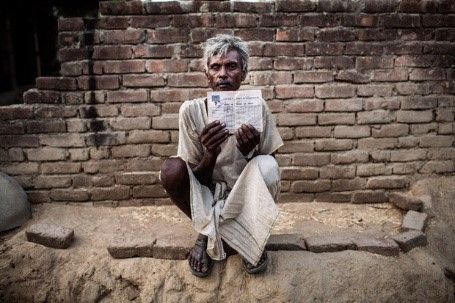
52-year-old Ram Kishen with his government provided ration card in Satnapur Village, Uttar Pradesh, India
The Government of Uttar Pradesh has taken a step towards the digitalization of Public Distribution systems (PDS) with its plan of linking them with Aadhar Card.
The Government, after recalling 80 lakh ration cards, had undertaken an investigation into the distribution of those cards as directed by the Chief Minister Yogi Adityanath. The ration cards have been taken back from the beneficiaries as these cards have the image of former Chief Minister of the state Mr. Akhilesh Yadav. Also the cards have Samajwadi party colors in them.
This is not a new action. Earlier in January this year, the government had stopped the distribution of over 60 lakh ration cards as they had the image of then Chef Minister Mr. Akhilesh Yadav. The Ghazidabad district magistrate gave those instructions to the district supplies office and ration card dealers citing the elections as the reason.
Also the government under Yogi Adityanath plans to have a new assessment of the Below Poverty Line (BPL) in the state. Officials have been directed to conduct new surveys among the BPL families in the state and to prepare a new list in accordance with that.
This would be seen as a welcome move as there has been drastic economic slowdown in the country, especially in the informal sector, following the demonetization move of the Narendra Modi led government in November last year. By conducting fresh surveys, the government will get a better assessment of the current situation and also the people will feel confident about the actions of the government.
Besides the probe, the government is planning to replace the existing ratio cards with Aadhaar linked ration cards. Such ration cards have been made available in some of the states in India such as Tamilnadu and this would be seen as a positive move by the government.
This action comes at a time when the PDS in the nation had been reassessed. The central government introduced new public distribution schemes, which reassessed and changed the benefits offered to the states. Every state in the country accepted the new scheme with Kerala being the last and a new revamped system has been put into place.
The UP governments’ move further improves the efficiency of the PDS by reducing the risk associated with fraud ration cards. Paper based ration cards are easy to duplicate and it has no additional security features. But with the introduction of new ration cards, which has silicon chips and bar codes that bears the beneficiary details, the risk of malpractice will be drastically reduced. Besides increasing the fairness of ration system, this provides a secure environment for the beneficiaries where the ration dealers are monitored systematically.
Till the new ration cards are made available, the beneficiaries will be given paper slips to avail their subsidized products.
Apart from this probe, the government also plans to set up a special task force to reclaim all the government land encroached upon by illegal means. The government plans to have a task force to stop the possession of government land by illegal means and a separate three-level task force to deal with land mafia.
All these government actions come at a time when the central government has been pressing towards digitization of banking. With its new banking regulations, the government is pulling people towards digital banking. With Uniform Basic Income Scheme under discussion, this could well be a move where the subsidies are made directly to the beneficiaries as made in the case of LPG subsidies.